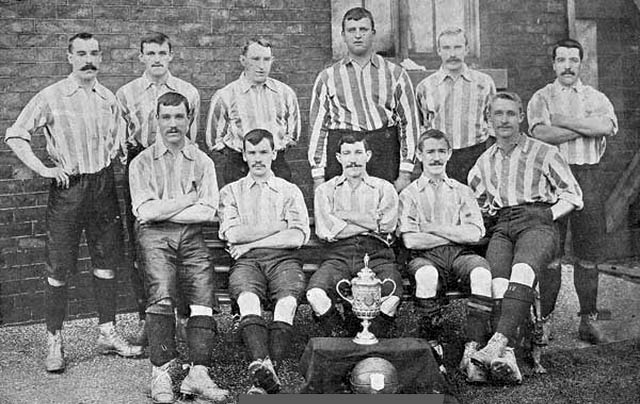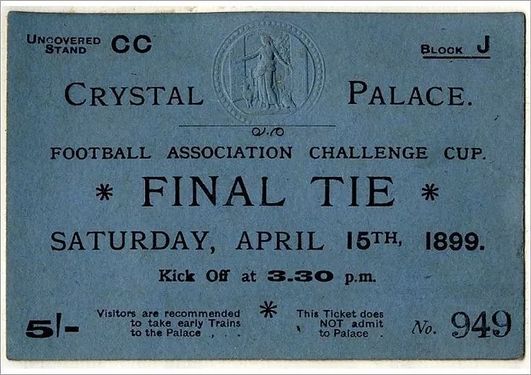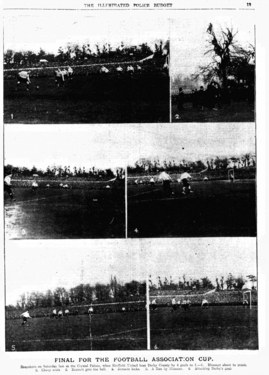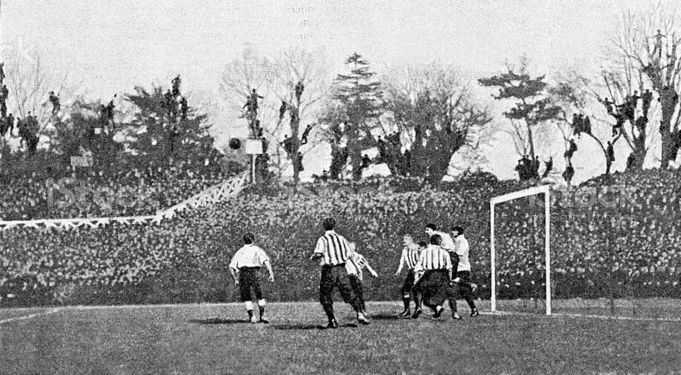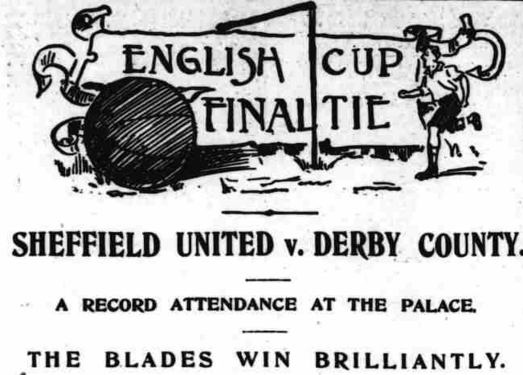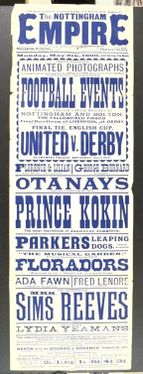1899 FA Cup Final (lost footage of football match; 1899)
The 1899 FA Cup Final culminated the 28th FA Cup season. Occurring on 15th April in front of a then-world record 73,833 at the Crystal Palace the match saw Sheffield United defeat Derby County 4-1 to claim its first FA Cup. The match was the second FA Cup Final to be filmed.
Background
Sheffield United and Derby County, as Football League First Division members, entered the tournament in the First Round Proper.[1][2] Sheffield United's road to the final saw it defeat Burnley, Preston North End, Nottingham Forrest, and, following four matches being required to decide the winner, Liverpool.[3][2] Meanwhile, Derby County's campaign consisted of it overcoming Woolwich Arsenal, Wolverhampton Wanderers, Southampton, and Stoke.[2] Both teams were seeking their first FA Cup, with Derby having lost the 1898 Final to Nottingham Forrest 3-1.[4][5][6] Meanwhile, this was Sheffield's first Final.[3]
A year prior, Sheffield optician Henry Jasper Redfern had begun associating with the filmmaking industry, providing Lumière Cinématographe exhibitions.[7][8][9] Utilising a stereoscopic camera, Redfern filmed events within Sheffield, including local cricket games.[9][7] The camera essentially showcased "animated photographs", where it captured several photographs in short order that would be combined to animate the action.[9] In 1899, he travelled to the FA Cup Semi-Final games Sheffield United were playing at, capturing footage of all four Liverpool encounters.[10][7] He would then travel to the Crystal Palace to capture footage of the 1899 FA Cup Final, making it the second Final to be filmed after Birt Acres' footage of the 1898 Final.[7][9][10] The five matches were showcased in a film entitled Football Events from 8th May 1899.[11][8][7]
However, the London-based Warwick Trading Company, an influential producer of British films during the Victorian era, were also interested in filming the match.[12][13] Based on surviving information of the film, it provided certain moments of the game, including the Sheffield players and officials entering the pitch, midfield play, a Sheffield corner, Derby's sole goal, shots of the crowd, and the players exiting the field.[13][10] None of Sheffield's goals were captured, because the actual film would be limited to around 300 feet of celluloid.[10][13] Thus, attempting to capture the entire game would have wasted celluloid, an expensive material during this time period.[13] Future FA Cup Finals would be partially filmed as part of newsreels from the 1900s onwards, with the 1938 edition becoming the first to be fully televised live.[14][13]
The Match
The Final itself occurred on 15th April, setting a world record attendance for a football match with 73,833 watching at the Crystal Palace.[15][16][17] Derby took the lead after 12 minutes following a strike from John Boag.[18][17][3][16] The Rams had several attempts to double their lead but failed to capitalise, with Derby's then-record goalscorer Steve Bloomer missing numerous chances.[17][3] Bloomer also engaged in a duel with Sheffield's left-half defender Ernest Needham, with Needham's strong tackles and relentless nature nullifying many of Derby's attacks.[17][3] Sheffield fought back in the second-half, with Walter Bennett equalising after sixty minutes.[17][18][3][16] A goal from Billy Beer five minutes later gave Sheffield the lead, with Jack Almond doubling the Blades' lead after 69 minutes.[17][18][3][16] Finally, Fred Priest sealed the win for Sheffield in the 89th minute.[17][18][3][16]
The encounter was considered a high-quality FA Cup Final, with Redfern promoting his recording of it as "the finest Football Animated Photograph ever taken".[3][8] This marked Sheffield's first FA Cup win; the club has since won a further three Cups, the last being in 1925 following a 1-0 win over Cardiff City.[19][3][5] For Derby, it was the team's second-consecutive Final defeat, leading to concerns the club was victimised by a "gypsy curse".[20][3][4] The curse allegedly occurred when the owners of Derby's stadium the Baseball Ground evicted Romani gypsies who were living at the area.[20] The Rams' fans were concerned the curse was legitimate after the club also lost the 1903 Final to Bury 6-0.[21][20][4] However, the curse was officially broken in 1946, Derby winning that Final 4-1 in extra time against Charlton Athletic, giving the club its first, and to date, only, FA Cup.[20][4]
Availability
Ultimately, neither the Redfern nor Warwick Trading Company recordings of the Final have survived.[22][13] The oldest surviving footage of an FA Cup Final originates from the 1901 replay, with Sheffield losing to Tottenham Hotspur 3-1.[22] Nevertheless, some photographs of the match have resurfaced, including a few from Redfern that were recovered in 2020.[23]
Gallery
Images
See Also
- 1937 FA Cup Final (partially found footage of football match; 1937)
- 1938 FA Cup Final (partially found footage of football match; 1938)
- 1939 FA Cup Final (partially found footage of football match; 1939)
- 1947 FA Cup Final (partially found footage of football match; 1947)
- 1948 FA Cup Final (partially found footage of football match; 1948)
- 1948 Summer Olympics (partially found television coverage of London Games; 1948)
- 1949 FA Cup Final (partially found footage of football match; 1949)
- 1950 FA Cup Final (partially found footage of football match; 1950)
- 1951 FA Cup Final (partially found footage of football match; 1951)
- 1952 Coupe de France Final (partially found footage of football match; 1952)
- 1955 Scottish Cup Final (partially found footage of football match; 1955)
- 1956 Southern Junior Floodlight Cup Final (lost footage of football match; 1956)
- 1966 FIFA World Cup Final (partially found original colour film of international football match; 1966)
- 1967 FA Cup Final (partially found footage of football match; 1967)
- 1968 Football League Cup Final (partially found footage of football match; 1968)
- 1970 FA Cup Final Replay (partially found original ITV coverage of football match; 1970)
- 1971 WFA Cup Final (partially found footage of football match; 1971)
- 1973 WFA Cup Final (lost footage of football match; 1973)
- 1974 WFA Cup Final (lost footage of football match; 1974)
- 1976 WFA Cup Final (partially found footage of football match; 1976)
- 1977 WFA Cup Final (lost footage of football match; 1977)
- 1978 WFA Cup Final (lost footage of football match; 1978)
- 1979 WFA Cup Final (lost footage of football match; 1979)
- 1980 WFA Cup Final (lost footage of football match; 1980)
- 1981 WFA Cup Final (lost footage of football match; 1981)
- 1982 WFA Cup Final (lost footage of football match; 1982)
- 1985-1986 WFA Cup (lost list of entries for football tournament; 1985)
- A Football Match at Newcastle-on-Tyne (lost footage of football match; 1896)
- Arsenal 1-1 Sheffield United (lost radio commentary of football match; 1927)
- Arsenal 7-1 Hibernian (lost footage of charity football match; 1952)
- Arsenal vs Arsenal Reserves (lost footage of early BBC televised football match; 1937)
- Atlético Madrid 1-1 Real Madrid (lost footage of El Derbi Madrileño La Liga football match; 1958)
- Barbados 4–2 Grenada (partially found soccer match footage; 1994)
- Barnet 3-2 Wealdstone (lost footage of Athenian League football match; 1946)
- Bedford Town 1-2 Arsenal (partially found footage of FA Cup match; 1956)
- Blackpool 0-1 Bolton Wanderers (lost footage of Football League First Division match; 1960)
- Brian Clough's Football Fortunes (lost DOS port of football management game; 1987)
- Carlisle United 2-1 Plymouth Argyle (partially found footage of Football League Third Division match; 1999)
- Charlton Athletic 1-0 Blackburn Rovers (lost footage of FA Cup match; 1947)
- Chelsea 1-1 Burnley (partially found footage of FA Cup match; 1956)
- Chelsea 2-0 Sparta Prague (lost footage of international football match; 1957)
- England 0-1 Scotland (partially found footage of international football match; 1938)
- England 1-0 Scotland (lost footage of Schools' International football match; 1952)
- England 1-1 Scotland (partially found footage of international football match; 1947)
- England 1-3 Scotland (partially found footage of international football match; 1949)
- England 2-0 Italy (partially found footage of international football match; 1949)
- England 3-0 France (partially found footage of international football match; 1947)
- England 3-0 Rest of Europe (partially found footage of international football match; 1938)
- England 6-0 Switzerland (partially found footage of international football match; 1948)
- Falkirk 3-2 Newcastle United (lost footage of football match; 1953)
- FIFA Soccer 2002 (lost build of cancelled Game Boy Advance port of football game; existence unconfirmed; 2001-2002)
- France 3-1 West Germany (partially found footage of international football match; 1952)
- France 6-3 Belgium (partially found footage of FIFA World Cup qualifying match; 1956)
- Hallo! Bundesliga (lost GolTV series; mid 2000s-mid 2010s)
- Hero to Zero (partially found BBC One children's football drama show; 2000)
- Juventus 1-7 A.C. Milan (partially found footage of Serie A football match; 1950)
- Lowestoft Town 3-0 AFC Hornchurch (partially found footage of Isthmian League Premier Division play-off final; 2014)
- Manchester United Championship Soccer (lost build of cancelled Sega Mega Drive port of football game; 1995)
- National Professional Soccer League (partially found footage of soccer matches; 1967)
- Netherlands 0-0 Sweden (lost footage of international football match; 1952)
- Premier League All Stars (partially found Sky One charity football tournament; 2007)
- PSV Eindhoven 2-1 E.V.V. Eindhoven (lost footage of Netherlands Football League Championship match; 1950)
- Real Madrid 1-0 Barcelona (partially found footage of El Clásico La Liga football match; 1959)
- Real Madrid 3-0 Racing Santander (lost footage of La Liga football match; 1954)
- San Lorenzo de Almagro 1-1 River Plate (lost footage of Argentine Primera División football match; 1951)
- Scottish Universities 1-1 English Universities (lost footage of international football match; 1952)
- Serbia vs Albania (found footage of abandoned UEFA Euro 2016 qualifying match; 2014)
- Stade de Reims 2-1 FC Metz (partially found footage of French Division 1 football match; 1956)
- United! (lost British soap opera; 1965-1967)
- Walthamstow Avenue 0-2 Queen's Park (lost footage of friendly football match; 1951)
- West Ham United 1-2 Tottenham Hotspur (partially found footage of FA Cup match; 1956)
References
- ↑ World Football detailing the 1898/1899 Football League First Division table. Retrieved 15th Nov '22
- ↑ 2.0 2.1 2.2 RSSSF detailing the road to the 1899 FA Cup Final. Retrieved 15th Nov '22
- ↑ 3.00 3.01 3.02 3.03 3.04 3.05 3.06 3.07 3.08 3.09 3.10 History of Soccer detailing the Final. Retrieved 15th Nov '22
- ↑ 4.0 4.1 4.2 4.3 Derby County detailing its trophy cabinet. Retrieved 15th Nov '22
- ↑ 5.0 5.1 Transfer Markt detailing Sheffield United's trophy cabinet. Retrieved 15th Nov '22
- ↑ 11 vs 11 detailing the result of the 1898 FA Cup Final. Retrieved 15th Nov '22
- ↑ 7.0 7.1 7.2 7.3 7.4 Victorian Cinema detailing Redfern's career in filmmaking. Retrieved 15th Nov '22
- ↑ 8.0 8.1 8.2 The Beginnings of the Cinema in England detailing the matches Redfern recorded as part of Football Events. Retrieved 15th Nov '22
- ↑ 9.0 9.1 9.2 9.3 The Remarkable Story of Fred Spiksley detailing the stereoscopic camera Redfern utilised to capture images of the games. Retrieved 15th Nov '22
- ↑ 10.0 10.1 10.2 10.3 The British Film Catalogue summarising Redfern and the Warwick Trading Company's films. Retrieved 15th Nov '22
- ↑ Science Museum Group providing a poster promoting Football Events. Retrieved 15th Nov '22
- ↑ Science Museum Group detailing the Warwick Trading Company's influence in early British filmmaking. Retrieved 15th Nov '22
- ↑ 13.0 13.1 13.2 13.3 13.4 13.5 The Bioscope detailing the Warwick Trading Company film of the Final, and noting the 1901 edition has the oldest surviving footage. Retrieved 15th Nov '22
- ↑ BBC detailing how it provided full live television coverage of the 1938 FA Cup Final. Retrieved 15th Nov '22
- ↑ Savage Events noting the Final drew a world record attendance of 73,833. Retrieved 15th Nov '22
- ↑ 16.0 16.1 16.2 16.3 16.4 11 vs 11 detailing the result of the match and other statistics. Retrieved 15th Nov '22
- ↑ 17.0 17.1 17.2 17.3 17.4 17.5 17.6 Archived FA Cup Finals summarising the Final. Retrieved 15th Nov '22
- ↑ 18.0 18.1 18.2 18.3 The Complete Record of the FA Cup detailing when each goal was scored. Retrieved 15th Nov '22
- ↑ FA Cup Finals detailing the result of the 1925 FA Cup Final. Retrieved 15th Nov '22
- ↑ 20.0 20.1 20.2 20.3 Spooky Isles detailing Derby County's alleged "gypsy curse". Retrieved 15th Nov '22
- ↑ FA Cup Finals detailing the 1903 FA Cup Final. Retrieved 15th Nov '22
- ↑ 22.0 22.1 Gottfried Fuchs blog noting the 1899 FA Cup Final films are lost, and noting the earliest surviving footage of a FA Cup Final originates from 1901. Retrieved 15th Nov '22
- ↑ England's Oldest Football Clubs providing photos and newspaper clippings of the Final, including some Redfern photos recovered in 2020. Retrieved 15th Nov '22
